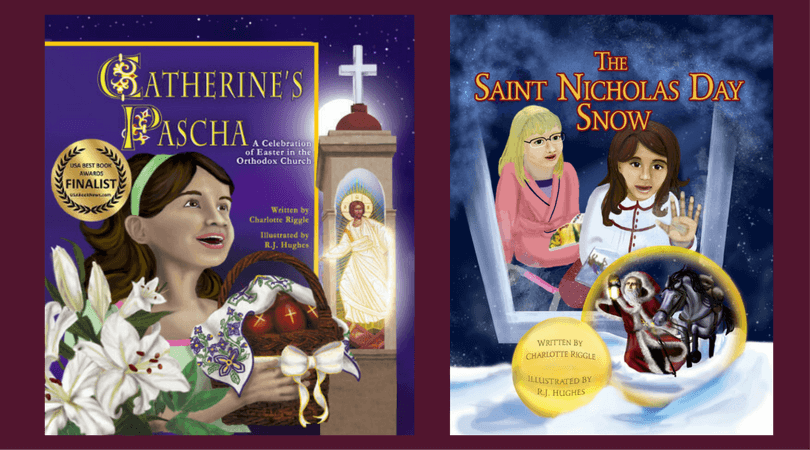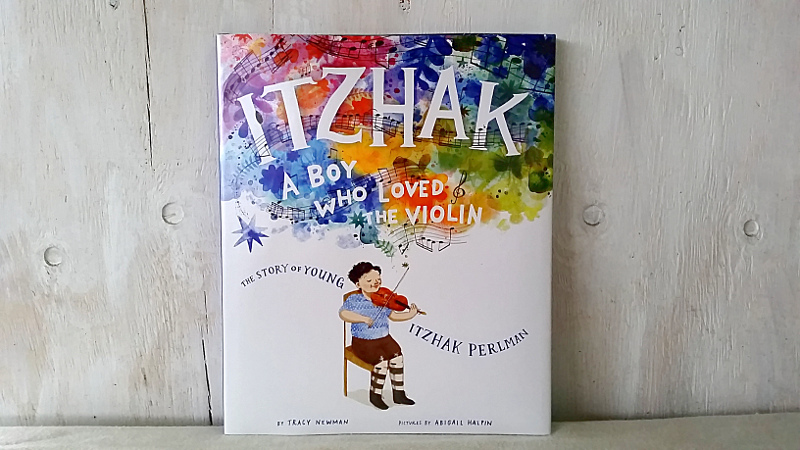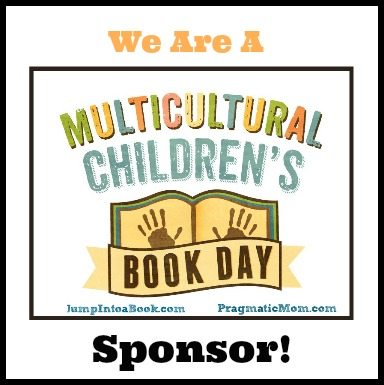When my children were small, I told them that there are true stories about real people, and made up stories about made up people, and made up stories about real people. Written by Tracy Newman and illustrated by Abigail Halpin, Itzhak: A boy who loved the violin is a true story about a real person, the famous violinist, Itzhak Perlman.
And Itzhak: A boy who loved the violin was named as an honor book in the 2020 Schneider Family Book Awards. The awards honor authors and illustrators for excellence in the portrayal of the disability experience in books for children. The honor is well deserved.
A bit of background on Itzhak Perlman
The first time I ever heard Itzhak Perlman was on Sesame Street, when he and a little girl talked about easy and hard. The girl raced up the stairs to a stage, then sat and waited while Perlman made his way to her. He looked at her and said, “Some things that are easy for you are hard for me. Then he played a bit on his violin. The tiny bit that he played took my breath away. And the little girl looked at him, when he was done, and said, “Some things that are easy for you are hard for me.” Then she played, and it was sweet and good.
Before you read Itzhak: A boy who loved the violin with your little ones, watch that clip with them.
In fact, even if your kids are older, watch the Sesame Street clip with them. And maybe watch Perlman’s debut on the Ed Sullivan Show in November of 1958. That was just a few months before I was born. Perlman was just 13 years old. You’ll read about the debut in the book, so seeing it, hearing it, enriches and extends the book.
Your oldest kids might be interested in reading a bit about Perlman’s synesthesia, which is mentioned in passing in the book, and learning about what synesthesia is. They might also be interested in learning a bit about Perlman’s perspective on his disability.
Like Perlman, Elizabeth, one of the main characters in Catherine’s Pascha and The Saint Nicholas Day Snow, uses crutches, and like him, she has braces. At times, she also uses a wheelchair. Your children might wonder if Elizabeth had polio. She didn’t. The first effective polio vaccine was developed in 1952, after Perlman contracted the disease, but long before Elizabeth was born.
Why read and watch Sesame Street first?
Watching Perlman on Sesame Street and Ed Sullivan, and reading about synesthesia and polio, will make it clear that this book is a real story about a real person. And that matters. Recently, teenagers on TikTok have come to believe either that Helen Keller was not a real person, or that if she was, she wasn’t really deaf and blind. They don’t believe that a disabled person can do the things that Keller did. It is so important that children and teens have disabled people in their lives and in their media.
Representation really does matter. You can find many more videos featuring Perlman on YouTube, and articles and interviews on NPR and other publications online. Seeing Perlman in different contexts, and learning a bit about him and his world, will help them know that disabled people and their accomplishments are very, very real.
The first thirteen years
Itzhak: A boy who loved the violin covers just the first 13 years of Itzhak Perlman’s life. Perlman was born in 1945, in Tel Aviv. His family was poor. They lived in “a single-room walk-up, with just one window … and no bathroom of its own.” Sometimes all they had for dinner was a bit of fruit and bread.
But they had a radio, and that radio filled their home, and Itzhak’s heart, with music. By the time he was three, he wanted a violin. His parents tried to fulfill this desire with a toy violin. It didn’t work. He wanted to make real music.
And then, when he was four, he got polio. Itzhak survived, but he couldn’t use his arms or legs. He had to relearn how to do everything. With many, many months of work, he regained the use of his hands and arms. But he would always need crutches and braces on his legs to walk.
That was okay. Because Itzhak wanted music. His parents got him a real violin, and lessons. He didn’t always do what his violin teacher wanted him to do, but he worked hard, and he learned to play.
Just two years after his bout with polio, Itzhak began playing with orchestras in Israel. When he was ten, he started giving solo performances. And when he was 13, he played on the Ed Sullivan Show.
The book ends with that performance, and the promise, “His life would never again be ordinary.”
The illustrations
There’s a certain kind of magic that sometimes happens in picture books, where the illustrator takes a solid story, and transforms it into pure gold. Abigail Halpin does that with Itzhak: A boy who loved the violin. There are ordinary pages, pages showing the streets of Tel Aviv or New York City, or children playing soccer, or a medical clinic, with Itzhak walking between parallel bars while his mother and a doctor look on.
And then there are the pages filled with music. Halpin can’t bring sound out of paper, of course. And yet, on the music pages, patches of color mix with leaves and flowers intertwined with flowing staffs of musical notes, and even angels. The effect is somehow intensely musical.
Extending the book
Newman and Halpin extend Itzhak: A boy who loved the violin with generous author and illustrator notes, a timeline of Perlman’s life, a bibliography, and footnotes. If you’re a teacher, whether in a classroom or at home, this end matter offers multiple ways to extend the book.
In the illustrator’s note, Halpin identifies the music she used in her illustrations. You can listen to that music with your kids, and, if you have the skills, find the music that she mentions in her illustrations in the book.
In the author’s note, Newman describes some of the struggles Perlman encountered because of his disability, and about his ongoing advocacy on behalf of disabled children. There’s a lot of content to engage with. (Unfortunately, Newman uses the term “wheelchair-bound children” in her note, so if you read the note with your children, you’ll want to let them know that “children who use wheelchairs” would have been a better way to say it.)
The timeline provides many opportunities for social studies and history lessons.
Itzhak: A boy who loved the violin is simply a fabulous book. The publisher says it’s for children ages 4 – 8. I would set the age range a bit higher, from 6 to 12. Preschoolers who, like Itzhak, already adore music will love the book, and there’s plenty of content to engage older children and tweens.
Read More
All the Way to the Top: A story of the Capitol Crawl: All the Way to the Top is the story of Jennifer Chaffin and the fight for the Americans with Disabilities Act. It was also a 2020 Schneider Family Book Awards honor book.
The Bat Boy and His Violin: Reginald’s papa is the manager of the Dukes, the worst team in the Negro Leagues. And all Reginald wants to do is play the violin.
The best picture books with disabled characters: It can be hard to find wonderful picture books with disabled characters. This list will help!
Buy the Books!

These delightfully diverse books provide disability representation (Elizabeth, one of the main characters, is an ambulatory wheelchair user). They also give Orthodox Christian children the rare opportunity to see themselves in books, and children who are not Orthodox the chance to see cultural practices they may not be familiar with.
Catherine’s Pascha
FINALIST IN THE 2015 USA BEST BOOK AWARDS
Catherine doesn’t like vegetables. She doesn’t like naps. She doesn’t like it when her mom combs her hair. She loves hot dogs, chocolate cake, and her best friend, Elizabeth. Most of all, she loves Pascha! Pascha, the Orthodox Christian Easter, is celebrated in the middle of the night, with processions and candles and bells and singing. And Catherine insists that she’s not a bit sleepy.
Celebrate the joy of Pascha through the magic of a book: Catherine’s Pascha. Available on Amazon, Bookshop.org, and my webstore.
The Saint Nicholas Day Snow
Shoes or stockings? Horse or sleigh? Does St. Nicholas visit on December 6 or on Christmas Eve? Will a little girl’s prayer be answered? When Elizabeth has to stay at Catherine’s house, she’s worried about her grandmother, and worried that St. Nicholas won’t find her. The grownups, though, are worried about snow.
Celebrate the wonder of St. Nicholas Day through the magic of a book: The Saint Nicholas Day Snow. Available on Amazon, Bookshop.org, or my webstore.



